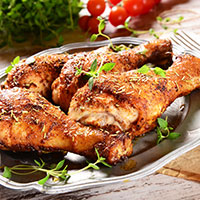| Mineral name |
Iron |
| What’s it used for? | Supporting haemoglobin – the body’s main oxygen-transporting molecule around the body, growth and energy production, enzyme function and antioxidant protection |
| Best food sources | Red meat, liver, kidney, pork, lamb, salmon, canned fish and eggs |
| How much do I need? | NRV is 14 mg per day* |
| Need to know | Low energy, breathlessness and fatigue are key signs of iron deficiency |
*A Nutrient Reference Value or NRV is the recommended level set by the UK Department of Health for daily nutrient intake
Iron
Iron’s key function is to carry the haemoglobin molecule around the body which contains 60-70% of the body’s iron. It is also carried in the blood to bone marrow, where it transports oxygen to the muscles and to the heart.
The haemoglobin molecule makes up about 30% of red blood cells and the remainder of the body’s iron is used for its various enzyme functions. Iron also plays an important role in the immune system by helping to increase production of killer cells, which protect against unwanted viruses and infections.
Why do I need it?
As with many minerals, iron is only needed in trace amounts in the body but still fulfils some really crucial functions. Unfortunately, deficiency is quite common in women 18-44 years due to the menstrual cycle.
Iron deficient anaemia is the most common sign of deficiency. A reduction in red blood cells leads to fatigue, pale skin and lack of energy. Other symptoms of low iron include sore tongue, cankers around the mouth, brittle nails, headaches, dizziness, hair loss and reduced brain development in children.
Additional iron is often needed during pregnancy because the growing infant will generally pull what is needs from the mother. Iron can often help women who have painful periods, and heavy periods can also be a sign of iron deficiency.
Best food sources
There are two forms of dietary iron: haem iron found in meats is more absorbable than non-haem iron found in vegetables, although green leafy vegetables, oats, dried fruits and fortified breakfast cereals are also good sources.
Iron is actually better absorbed if eaten with citrus fruits or other fruits containing high levels of vitamin C such as berry fruits or kiwis.
Foods high in iron

Beef – 2.9 mg per 100g

Turkey – 2.3 mg per 100g

Chicken leg – 1.3 mg per 100g

Tuna – 1.3 mg per 100g

Chicken breast – 1 mg per 100g
Are you getting enough?
The population at greatest risk for a diet deficient in iron, is the elderly. This is mainly due to decreased absorption from reduced stomach acid production as we age, but also poor dietary intake. Teenagers with highly refined diets and women with a menstrual cycle are also at risk.
The negative effects of iron deficiency are caused by lack of oxygen delivery to the body tissues, which primarily will cause decreased energy levels and physical performance. Ultimately, a lack of iron will cause iron-deficient anaemia. However, iron-dependent enzymes involved in energy production and metabolism are the first to be affected by low iron levels.
Did you know?
Iron absorption can be improved by taking 250 mg of vitamin C supplements between mealsThe ferrous sulphate form of iron, routinely given for anaemia, can cause constipation and black stools; the citrate form is much better tolerated
Iron is suitable to take during pregnancy and breastfeeding at the recommend dosages – consult your healthcare professional for advice
Indeed, many pregnant women will be low in iron due to the growing baby taking what it needs
Iron overdose can be dangerous for children
For all the latest research on iron click here
Try this
Iron is found in the Alive! range of multi vitamins and minerals.
For more information visit www.feelaliveuk.com
You can also follow Alive! on Twitter for general health and wellbeing tips: @feelaliveuk



